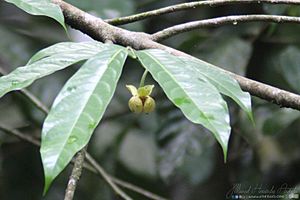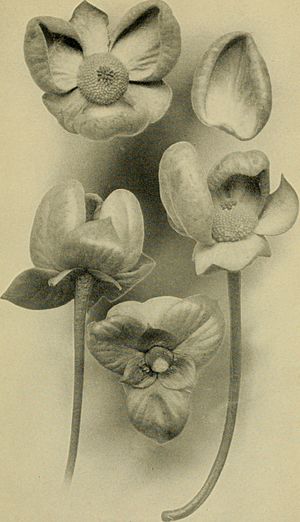Cymbopetalum penduliflorum facts for kids
Quick facts for kids Cymbopetalum penduliflorum |
|
|---|---|
 |
|
| leaves and a young flower of Cymbopetalum penduliflorum | |
 |
|
| Cymbopetalum penduliflorum flowers | |
| Scientific classification | |
| Genus: |
Cymbopetalum
|
| Species: |
penduliflorum
|
| Synonyms | |
Cymbopetalum penduliflorum is a type of plant that belongs to the Annonaceae family. Its scientific name, penduliflorum, comes from two Latin words: pendulus, meaning "hanging," and florum, meaning "flowered." This name describes how its flowers hang down.
What it's Called
This plant is often called the "sacred earflower." In Spanish, people call it flor de la oreja or orejuela, which also means "ear flower." In the Nahuatl language, it is known as xochinacaztli. In some parts of Guatemala, like Todos Santos Cuchumatán, it's called tzchiquin itz in the Mam language. The Qʼeqchiʼ people near Cobán call it muc'.
What it Looks Like
The sacred earflower grows as a tree or a small shrub. Its leaves are arranged in two rows and are shaped like a spoon, getting wider towards the tip.
The plant has single flowers that grow on long, thin stems called peduncles. These stems come from the smaller branches. The outer parts of the flower, called sepals, are wide and round. The outer petals are similar but much larger than the sepals.
The inner petals are thick and fleshy. They curl inwards, making them look a lot like a human ear. When the flowers are fresh, they are a greenish-yellow color. The inside of the inner petals often looks orange. As they get older, they turn a brownish-purple or maroon color. If you break them, the inside will be a bright orange.
Traditional Uses
Long ago, the dried flowers of C. penduliflorum and a similar plant, C. costaricense, were used to add a spicy taste to chocolate. This was before spices like cinnamon came from other parts of the world.
Even today, the dried petals are used in traditional drinks like atoles and pinoles. They are also sometimes added to coffee.
Where it Grows
This plant naturally grows in the mountains of southern Mexico, Guatemala, and El Salvador. People still grow it as a spice in parts of Guatemala, especially around Cobán and Jacaltenango. You can find these flowers sold in markets in those areas, as well as in Antigua Guatemala, Santa Ana, El Salvador, and San Andrés Tuxtla, Mexico.
See also
 In Spanish: Flor de oreja para niños
In Spanish: Flor de oreja para niños

